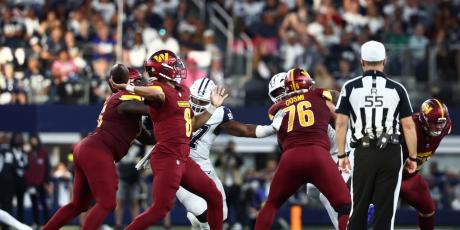A Profitable Gameplan for NFL DFS on FanDuel

Whether you are new to DFS or are a profitable, seasoned vet, it’s always good to start the season with a refresher, especially if NFL is the only daily fantasy game that you play. Once the season starts, it’s all about value and building the most profitable lineups, but lineups need to be built on a solid foundation to be profitable. That foundation is proper bankroll management and game selection.
This season, I will be writing the weekly FanDuel Breakdown, where I go over my favorite cash and GPP plays as well as any week-specific strategies that I find especially noteworthy. Here, I will lay out my weekly process along with some best practices for maximizing all of the content and tools available at 4for4.
Bankroll Management
For anyone that sets out to be a long-term, profitable DFS player, proper bankroll management is key. Last season, I wrote a three-part series highlighting my thoughts on the theory of bankroll management. I’d highly recommend reading that entire series, especially if you are new to DFS, but one quote mentioned in that series from my friend and former 4for4 scribe Jonathan Bales emphasizes the importance of understanding bankroll maybe more than anything I’ve come across:
“If you have a normal distribution of tournament finishes and a 20% long-term ROI, you still have somewhere around a 16% chance of being down after a sample of 1,000 GPPs. You read that correctly. If you are a big long-term winner and play one tournament lineup per week, you have somewhere around a one-in-six chance of still being down after 62.5 seasons of NFL action.”
Keep this in mind as I go over some of my general bankroll guidelines and you want to skip this reading to fire off 150 entries into the Week 1 Millionaire.
Your True Bankroll
It goes without saying, but before building a bankroll strategy, you have to know what your actual bankroll is. This might seem obvious, but I’ve seen it botched time and time again. Your true bankroll isn’t the money that you have on a website after your initial deposit—your bankroll is the amount of money you will comfortably invest in NFL DFS over the entire season. Calculating your bankroll strategy any other way either exposes you to an unnecessarily high risk of ruin or caps your upside.
Let’s assume that you deposit $500 on both FanDuel and DraftKings before Week 1, but you can comfortable replenish any amount up to $2,000 throughout the season. In this case, you should calculate your game mix with a starting point of $2,000 even though that’s not what you keep on the site.
Choosing Your Game Mix
Deciding your mix of cash games versus GPPs is a matter of risk tolerance and goal setting, but a general rule of thumb is that the more cash games you play relative to tournaments, the more of your bankroll you can play and vice versa. A widely accepted starting point for this game mix is the 80/20/10 rule—this means 80% of your money in play in cash games, 20% in tournaments and no more than 10% of your total bankroll in play at one time. My upper limit is 20% of my bankroll in play, but that is only on very rare occasions and in those cases, my game mix is heavily slanted toward cash games. For beginners, I’d highly recommend a 90/10/10 mix.
For most players, the most important thing is to keep your **percentage* of money in play consistent, rather than the dollar amount. Again, we’re looking to maximize upside while limiting downside. Putting the same dollar amount in play that you started with after a couple down weeks can have your bankroll approaching zero rapidly, while a consistent percentage will keep you afloat during thin times. Similarly, if you win a couple of weeks in a row, but stick with your initial weekly allocation of money, you could be missing out on the opportunity to move up in stakes and possibly play more profitable games, whether it be smaller-field tournaments or lower-raked games.
Game Selection
Probably the most popular question I get beside who to play is what games to play. My simple answer is to play as many games as possible at the lowest stakes possible. I’ll repeat it again: maximize growth, minimize risk. There are some specifics to consider depending on each situation.
Types of Cash Games
Ideally, you want to play as many head-to-head games as possible against as many opponents as possible but bankroll considerations have to be taken into play. In order to minimize variance, you want to be able to play about 30 head-to-heads at a given buy-in level. Without going too deep into a statistics lecture, 30 is where any random sample begins to approach a normal distribution of outcomes. In other words, that is where you should see a win rate that closely reflects how good your cash game lineup actually is.
Consider this scenario. You build a cash game lineup that finishes in the 80th percentile of all cash lineups that week. If you are only able to play five head-to-heads, natural variance could easily see you matched up against five lineups that finished in the 81st percentile or higher. If your bankroll doesn’t allow you to play close to 30 head-to-heads at a given buy-in level, then it makes sense to play 50/50s (I generally advise against double-ups, especially for beginners, as it takes a higher win rate to be profitable in those games. Also be sure to seek out single-entry contests). While a 50/50 is inherently more volatile than a head-to-head because 50/50s will require a minimum score to win, there are ways to combat that variance if you can’t afford to play a lot of head-to-heads, namely through lineup diversification.
How Many Lineups Should You Play?
My strategy is fairly simple: if you’re playing head-to-heads, play one lineup; if you’re playing 50/50’s play multiple lineups. In head-to-head games, we are looking for diversification of opponents in order to get results that match the quality of our lineup. In 50/50s the safety net of recognizing the true value of your lineup doesn’t exist. Say you have a lineup that finishes in the 45th percentile of all cash lineups. If you play 100 head-to-heads, you will likely win about 45 of those contests. In a 50/50, you win nothing. So if you are someone that can only afford to play a few games a week, the best bet is to enter a handful of 50/50s with slightly different lineups in order to alleviate the risk of turning in a zero ROI week.
Which Tournaments Should You Play
It’s always going to be tempting to play the games that offer the biggest payouts but that is rarely the most profitable strategy. At the very least, you want to put yourself on an even playing field. If you can’t afford to play 150 lineups in a tournament, you’re at an inherent disadvantage to those that can. While player diversification is key in tournaments, seeking out single-entry or three-max contests can give you your best shot at cashing a GPP, especially if those contests have relatively small fields—usually you have to do some searching to find these games as they won’t be featured at the top of the lobby. As your bankroll grows, you can play bigger tournaments, with more lineups and a larger player pool.
A final thing to consider when building your game selection strategy is to play multiple slates. This lets you naturally diversify your lineups without forcing suboptimal plays and you will also get exposure to opponents that you might not get by only playing the main slate.
Using 4for4 Breakdowns and Tools
Throughout the season, I will expand on actual lineup-building strategies and specific player exposures but I wanted to lay this foundation before my first breakdown of the season hits 4for4. The best way to use 4for4’s content and tools is together. Just like you should never blindly take any fantasy advice, it’s unwise to simply go to the Lineup Generator and hit optimize. Take the time to read through each breakdown and see which points you agree with and which ones you don’t.
Even if you omit a couple of my suggestions, each week, I will give you plenty of options at each position to populate a significant but focused player pool into the 4for4 Lineup Generator. Once you’ve generated multiple lineups, you can apply my recommendations on how to build the most profitable lineups in a given week to pick which lineup best suits your game of choice—sometimes the lineup with the highest projected point total may not be the best choice, especially in games such as GPPs or multipliers where we favor upside and contrarian thinking. For more DFS theory, make sure you are subscribed to the DFS MVP Podcast and always feel free to shoot me questions on twitter @TJHernandez.




















